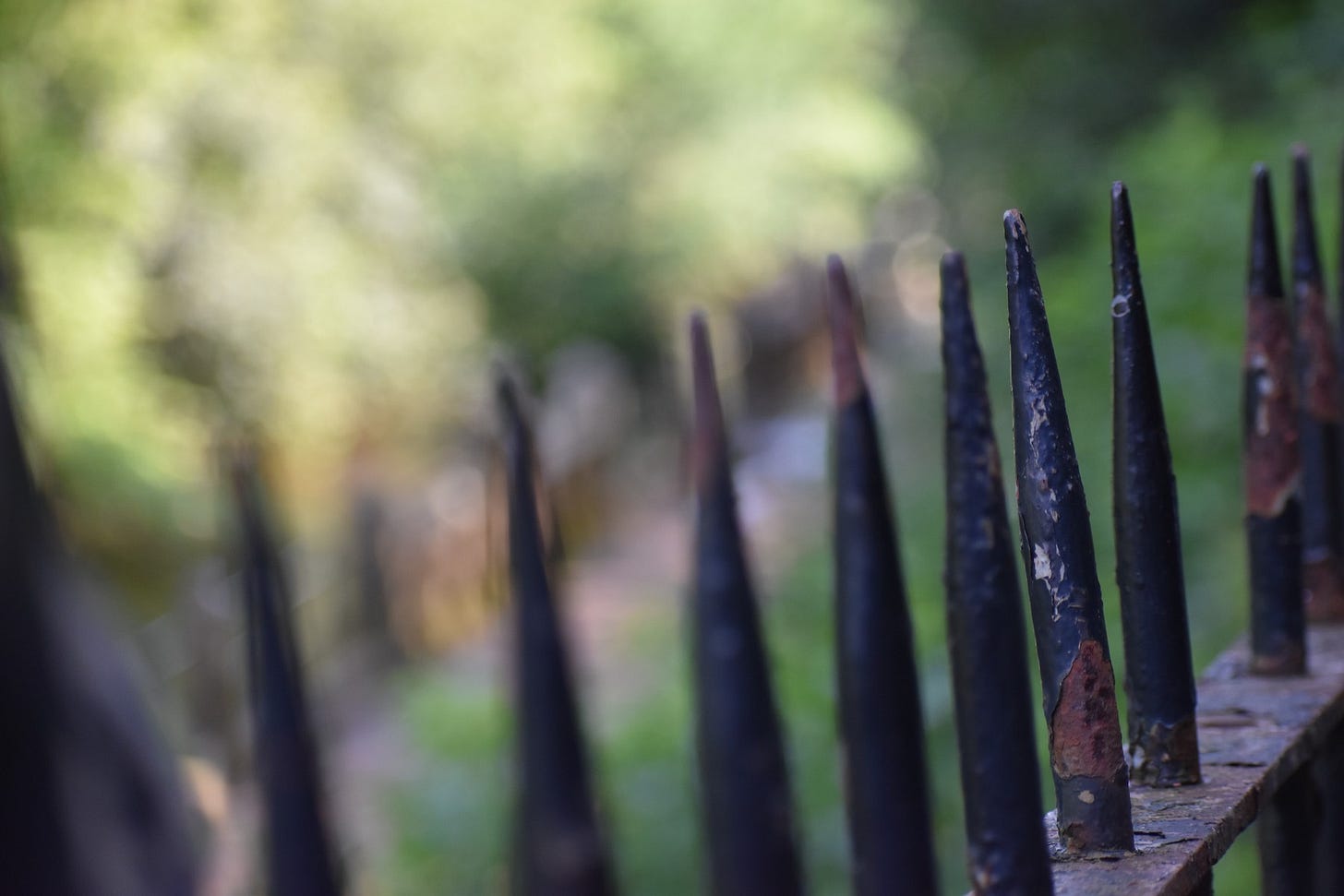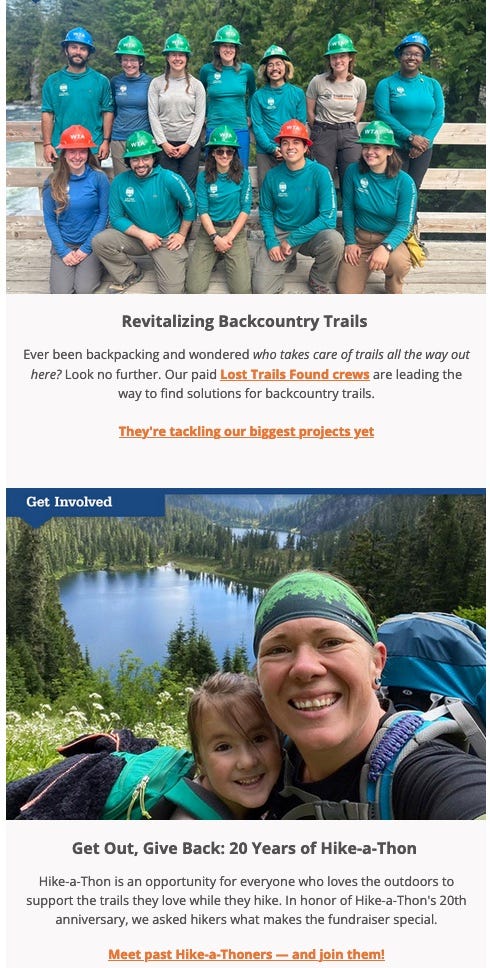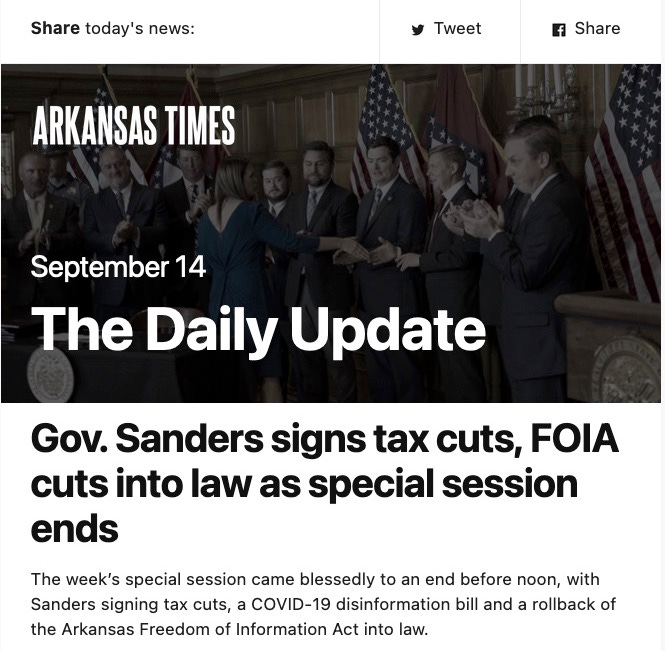We asked for joy and brilliance ☀️
Thoughts on newsletters that are exciting, inspiring and "like candy"
A few weeks ago I asked around for examples of nonprofit newsletters that bring joy. Are there newsletters you love, rely on, even look forward to opening?
I received a few enthusiastic, even joyous (well, that might be pushing it) responses.
And some not so enthusiastic responses. We’ve all seen (and not bothered opening) our share of boring nonprofit newsletters. 🥱
Regardless, the results offer some insights into effective newsletters and member communications.
[1] Have a point of view. Be relevant.
Seems obvious but doesn’t often happen.
Just because your staff worked on something doesn’t make it relevant.
From our examples, it helps to have a close connection to readers - one that uses content and news to build a relationship and trust. Small groups should have an advantage here.
One colleague shared the newsletter of a local SURJ (Standing Up for Racial Justice) chapter with this note:
we are small and can deliver just the "news" our membership wants. We use the same format and categories every time and always have several relevant items in each - which I believe creates confidence in our audience that it's worth opening.
In a small group, a few hundred to a few thousand people with a clear purpose, it’s easier to identify relevance. There are well-defined recruitment moments and processes. The mission is clear while member activities are connected to outcomes and (importantly) fundraising. Purpose and theory of change are on display, talked about, and reported on.
Larger organizations have more programs, more staff and a greater need to build and constantly replenish an email list. Recruitment is constant, everywhere and optimized for conversions. The long-term value of a supporter may be calculated but takes a back seat to short-term cost.
Newsletters become a place to promote programs, not meet the interests and needs of supporters.
Here are a few ways to rebalance newsletters - and communications - towards relevance:
Be clear at the start about who you are…
…and what you’re doing and how people fit into change. Put a three bullet list of mission, priorities, outcomes (some combination of these) in your messaging - recruitment, actions, onboarding, fundraising, website, etc.
Cultivate people’s ideas and interests in the onboarding process.
Run short surveys. Give people three action/activity ideas to respond to in a welcome message. Track responses, interests, feedback and which actions are chosen.
The Accidentally Wes Anderson newsletter offers an example of a newsletter (and social media user) survey. Several weeks after subscribing, receiving a welcome series and newsletters you’re invited to take a survey. Here’s a look at the flow.
Survey invite in an email:
Survey front page:
The survey is around 25 questions. It’s long. But the questions aren’t complicated and the offer of a prize at the end is valuable and in keeping with the “quest for adventure” tone of other email and web content.
Post-survey thank you:
Acknowledge the limits (and promise) of onboarding and engagement opportunities.
Many (most?) people aren’t going to respond to an onboarding survey or feedback campaign. This indirect cultivation won’t excite staff (and consultants) in organizations with metrics focused on fundraising. And that’s okay.
The responses you receive will identify your most enthusiastic new supporters and their interests. This valuable info can feed into your email (newsletter) strategy. This is also an opportunity to test how to increase response. Engage people early and you’re more likely to keep them around.
Show people getting things done.
Supporters like creating results whether you’re doing advocacy, training, direct service or even policy. A colleague shared the Trail News newsletter put out by Washington Trails Association. They said it works because it’s a consistent newsletter that has:
a monthly magazine format, a digest that has “candy” for the reader (like local hikes or events) and blends in accomplishments.
[2] Don’t send to everyone.
This ties into relevance. If you’re a larger organization with 20k, 100k or a million addresses on your list, how do you know everyone wants your newsletter? But that’s what many (most) groups do. Subscribers get newsletters.
Despite our best intentions, many subscribers and supporters aren’t at a newsletter-ready spot in their engagement with our issue or organization. And a pretty general, broad and/or dense newsletter isn’t inviting.
Groups end up with lousy newsletter open and click rates. They conclude newsletters don’t work and either shut it down or (more likely) let it limp along without intervention which damages the whole email program.
Invite supporters to subscribe to your newsletter. Let them see samples that show what they’re getting before subscribing. Create newsletters that are clear, specific and have a purpose.
[3] Be at least a little amazing.
Another colleague shared newsletters from Mobilisation Lab and The Forge saying they worked because they are “scannable/readable, exciting, inspiring.” That’s high praise for communications coming from a movement or nonprofit organization. It’s high praise for any newsletter, really.
Readable, exciting and inspiring are good descriptors of all the favorite newsletters shared with me.
Relevance matters here (see above).
Having something to say is critical. Don’t just make people happy. Push people to think. Tell supporters something new (and/or newsworthy). Have a voice. Be opinionated. As Bonnie Raitt has been known to say: “give them something to talk about…a little mystery to figure out.”
Too often, newsletters equate “interesting” with visuals and graphic design. Splashy or attractive header images get more attention than readable fonts, colors, white space and informative/useful graphics.
Consider the full range of content design, not just logos and images. It’s no coincidence that a colleague used scannable and readable alongside exciting and inspiring to describe their favorite newsletters.
Images and graphics can (ideally should) inform and help tell a story given the brief time you have with your reader. A header serves the story, not just the logo or brand. Here’s a header from the Arkansas Times daily newsletter:
Sidebar: the dark header image of clapping middle age white guys amps up the grim headline. Indeed, who needs info about government corruption?
[4] Be brilliant for those who care. Others will show up.
To sum it up…don’t try to create a newsletter for every reader (or every staff or board member). Be brilliant and passionate for those who care most. Be useful. Give them something to talk about and they will. Others will follow.
Get Reading
Who has a role to play in our civic infrastructure? Nonprofit and local journalism is often talked about as a last best defender of democratic institutions. But there’s a role for community groups and NGOs as sources of news and civic building. Lizzy Hazeltine of North Carolina Local News Lab Fund writes about if, how and why to think more broadly about identifying, reporting and sharing local news who has a role in that work.
Public media and the future of local journalism. NPR and local media folks got together this summer to create a report on how investment in local media is essential to communities and democracy.
Want to boost local news subscriptions? Giving your readers a say in story ideas can help. Researchers took a look at how newsroom reader engagement projects (soliciting story ideas, for example) ties to paid subscription rates. [Sophie Culpepper / Nieman Lab]
Related: What 7,500 news readers say about supporting and engaging with newsrooms. Readers are willing to pay for news and those that do are seeking connection to the news, not swag. This isn’t in the data here but I think people want to both see their ideas reflected in news and see news having a role in community change and direction. [Teresa Listow / BlueLena]
While we’re talking about news and community: How to turn active followers into active community members. Organizations often talk about community and go straight to tech platforms. Probably because tech mediates so much of our engagement with supporters: social media platforms, ad tech, content management systems, CRMs, fundraising and payment systems. Knowing if and when to use Slack, Discord and such is important. But so are events (in real life perhaps!), content strategy, and good old participation. [Noémie Kempf / The Audiencers]
Don’t tune out the kids, says the Teens Tuning In report from Medill’s Local News Initiative. Teens are spending more time with local news than people (aka adults aka most folks running news, advocacy and community institutions) realize. Unsurprisingly, teens are finding news on TikTok and other social platforms. They’re also on YouTube, Google/Yahoo News and podcasts but local and national TV are the biggest news sources.
Why email is still the original killer app. [Tim Huelskamp / Rolling Stone]
Email nerds: get your DKIM and SPF in share because Gmail is rejecting unauthenticated email. [Al Iverson / Spam Resource]
Africa’s storytelling evolution: how podcasting boosts minority voices, and can reinvigorate newsrooms. Podcasts aren’t just for your dog walk. They have a place in oral storytelling traditions and can deliver news to people who, for many reasons, aren’t accessing printed news. [World Association of News Publishers]
The content strategy of charity blogs: a study. Content strategist Lauren Pope reviewed 50 UK charities to learn how organizations are using blogs and what they’re posting. Pope found that many are hard to find and use. Like much nonprofit content it can be easier to google search than use site navigation.
Get Paid
Lots of jobs. These are the most recent ones. A more complete list is updated daily and available here.
Journalism, media and content strategy
News Editor : Committee to Protect Journalists [Hybrid in New York City]
Data Reporter : Lighthouse Reports [Remote / Global]
Vice President of Local Partnerships : American Journalism Project [Remote]
Fact Checking Lead : Rest of World [New York]
Community Manager : The Lenfest Institute [Philadelphia / Remote in the mid-Atlantic region]
Staff Writer and Staff Writer, Generative AI : Nieman Lab [Remote]
Newsletters Editor, US : The Guardian [New York City]
Director of Social Media : The New Yorker [New York City]
Executive Director : Society of Environmental Journalists [Remote]
Nonprofit organizations
See below for communications-specific roles.
Director of Advancement : Monument Lab [Hybrid in Philadelphia]
Chief Executive Officer : Mind Share Partners [Remote]
Digital Fundraising Manager and Digital Mobilization Senior Manager : Climate Reality Project [Hybrid in Washington, DC]
Global Head of Partnerships, Operations Director, Head of European Campaigns and Advocacy + other roles : Fossil Fuel Non-Proliferation Treaty Initiative [Remote / Global, Europe or Latin America]
Digital Communications Manager : Equality Federation [Remote in the US]
Project Manager : Invest in Open Infrastructure [Remote]
Associate Policy Director and Partner Engagement Manager : California Climate & Agriculture Network [Remote / regular travel to Sacramento required]
Program Coordinator : Beyond Carbon Fund and Beyond Carbon Action Fund [Remote in Southeast or Midwest US]
LA Housing Movement Lab Director : SAJE / Strategic Actions for a Just Economy [Los Angeles]
Director of Marketing : The Center [Hybrid in New York City]
Chief Policy Officer : Western Landowners Alliance [ Remote / Denver preferred]
Content Manager : Equal Justice USA [Remote / Brooklyn]
Senior Digital Web Content Strategist : NARAL [Washington, DC / Remote]
Social Media Strategist/Senior Social Media Strategist, Digital Advocacy : Center for American Progress [Hybrid in Washington, DC]
Communications
Mostly at nonprofits/NGOs.
Head of Communications : New Public [Remote]
Director of Marketing and Communications : TRAILS [Remote in the US]
Communications Director : Rails-to-Trails Conservancy [Hybrid in Washington, DC]
Associate Director of Communications : Caring Across Generations [Remote]
Senior Program Director: Climate Justice : Resource Media [Remote]
Managing Director, Communications : Climate Power [Remote in the US]
Communications Director : United We Dream [Remote / Strong preference for Washington, DC]
Communications Lead : For the Many [Remote in NY Hudson Valley / Dutchess, Orange, Ulster or Columbia Counties]
Communications Director : Chicken & Egg Pictures [Hybrid in Brooklyn]
Director of Communications : Callen-Lorde [New York City]
Director of Communications : Sitar Arts Center [Hybrid in Washington, DC]
Director, Clean Transportation Communications : Climate Nexus [Remote]
Communications Director : Global Alliance for the Future of Food [Remote]
Foundations
Social Impact Officer : The Beacon Fund [Hybrid in Denver]
Executive Director : Appalachian Community Fund [Remote in Appalachian Region / Main office in Knoxville, TN]
Strategy Officer for Innovation and Discovery : Lumina Foundation [Hybrid in Washington, DC]
Program Associate, Events and Member Management : Global Philanthropy Project [Remote / Global]
Manager, Grants Team : Walton Family Foundation [Denver]
Politics, products, projects & anything else that doesn’t fit above
Creative Director : Constructive [Remote in North America]
Senior Director of Partnerships : Candid [Remote or Hybrid from a Candid office]
CIO and Executive Director : Colorado Governor's Office of Information Technology [Denver]
Look at you, hero, reading every word and making it to the end. Thanks for reading Future Community! 👍🏼 Feel free to click reply or comment to leave feedback, share a link or job post.





